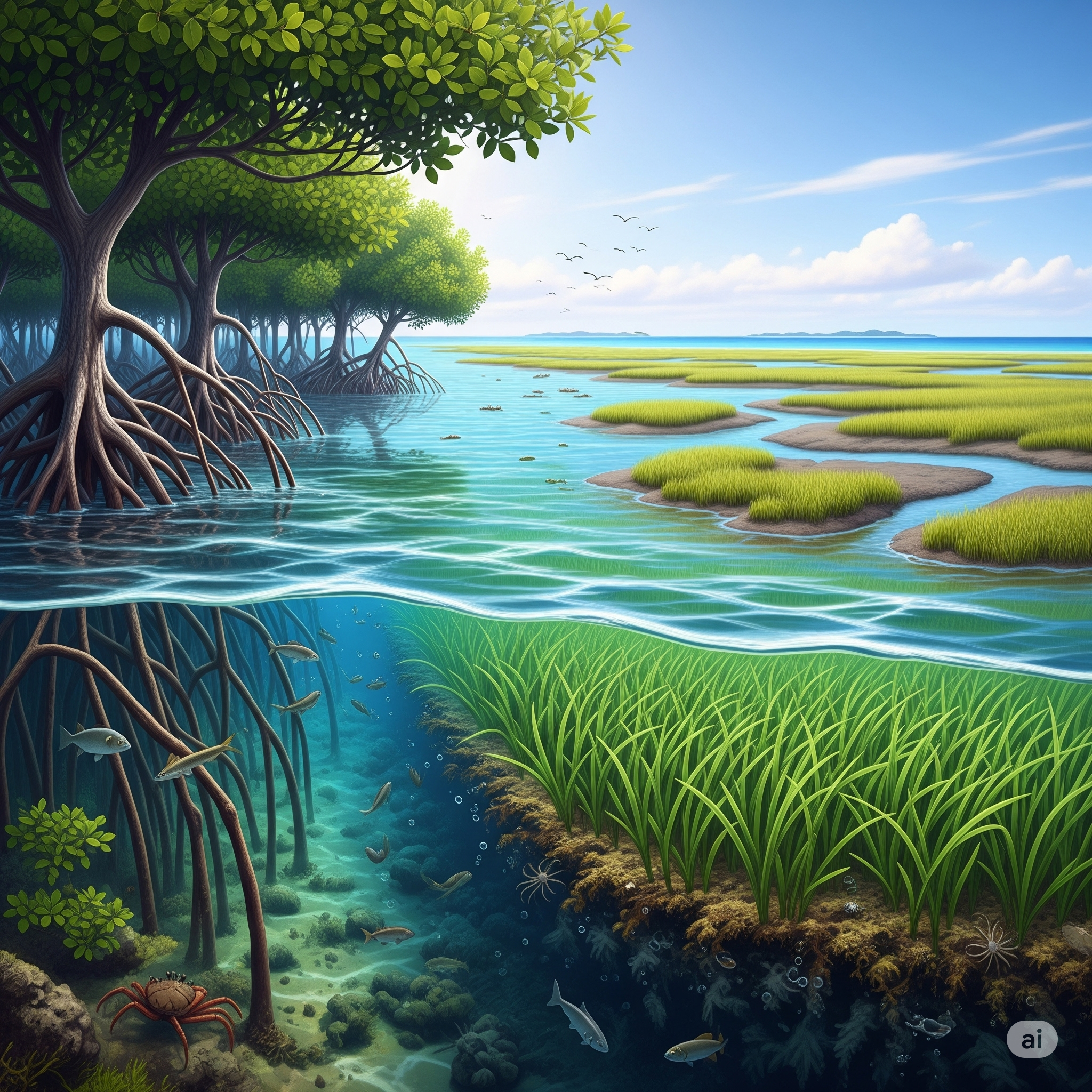Blue carbon refers to the carbon captured and stored by coastal and marine ecosystems. This concept specifically encompasses carbon sequestration in coastal wetlands with vegetation cover, such as seagrass meadows, mangrove forests, and salt marshes.
The long-term storage of atmospheric carbon dioxide (CO₂) in these ecosystems’ carbon pools is increasingly recognized as a nature-based solution for combating climate change. The services provided by coastal ecosystems, however, are not limited to carbon sequestration. They also include shoreline protection, biodiversity support, fisheries productivity, and food security. For this reason, the concept of blue carbon carries both ecological and socio-economic significance.

Representative Image of Blue Carbon Ecosystems (AI-generated)
Biological and Ecological Characteristics of Blue Carbon Ecosystems
Mangrove Forests
Mangroves are composed of salt-tolerant plant species commonly found in tropical and subtropical coastal zones. Their root systems enable the deposition and storage of carbon in organic form across both terrestrial and marine environments. Mangrove forests rank among the most efficient natural systems in terms of per-hectare carbon storage capacity. Organic matter accumulated beneath the soil surface can remain preserved for centuries under anaerobic (oxygen-deprived) conditions.
Seagrass Meadows
Seagrasses are submerged flowering plants that perform photosynthesis underwater. They sequester carbon in both their biomass and surrounding sediments. The carbon burial rate of seagrasses can even surpass that of tropical rainforests. Additionally, seagrass meadows stabilize marine sediments, reduce shoreline erosion, improve water quality, and provide critical nursery and habitat grounds for marine fauna.
Salt Marshes
Salt marshes are coastal wetlands of temperate regions dominated by plant species adapted to saline or brackish waters. They store organic carbon over long timescales and serve as buffer zones against sea-level rise. However, human-induced drainage, agricultural conversion, and urbanization threaten the persistence of these ecosystems.
Role in the Carbon Cycle and Relationship to Climate Change
Blue carbon ecosystems act as natural carbon sinks, capturing greenhouse gases from the atmosphere and mitigating the impacts of climate change. They can store carbon for centuries within soils and vegetative biomass. Research suggests that mangroves may hold four to ten times more carbon than terrestrial forests. Conversely, when these ecosystems are degraded, the stored carbon is released back into the atmosphere, exacerbating global warming. Thus, the conservation of blue carbon systems is critical not only for carbon sequestration but also for preventing the release of existing carbon stocks.
Threats to Blue Carbon Ecosystems
Blue carbon ecosystems face significant anthropogenic and climatic pressures. Urban expansion, agriculture, industrial activity, and tourism contribute to their degradation and loss. For instance, it is estimated that between 25% and 50% of the world’s mangrove cover has disappeared over the past 50 years.【1】 Climate change impacts—such as sea-level rise, increasing temperatures, and greater storm frequency—further threaten salt marshes and seagrass meadows. Addressing these threats requires nature-based solutions at both local and global scales.
Conservation, Management, and Sustainability Strategies
Sustainable management of blue carbon ecosystems emphasizes integrated coastal zone management approaches. Effective strategies include the expansion of protected areas, support for natural regeneration, and community-based restoration projects. Furthermore, integrating blue carbon into national and international carbon markets as measurable and tradable credits creates economic incentives for the protection of these ecosystems.
Research Directions
Maximizing the potential of blue carbon requires multidisciplinary research and comprehensive databases. Priority areas in the international literature include quantifying carbon stocks, determining rates of carbon burial, and assessing the restoration potential of degraded ecosystems.

